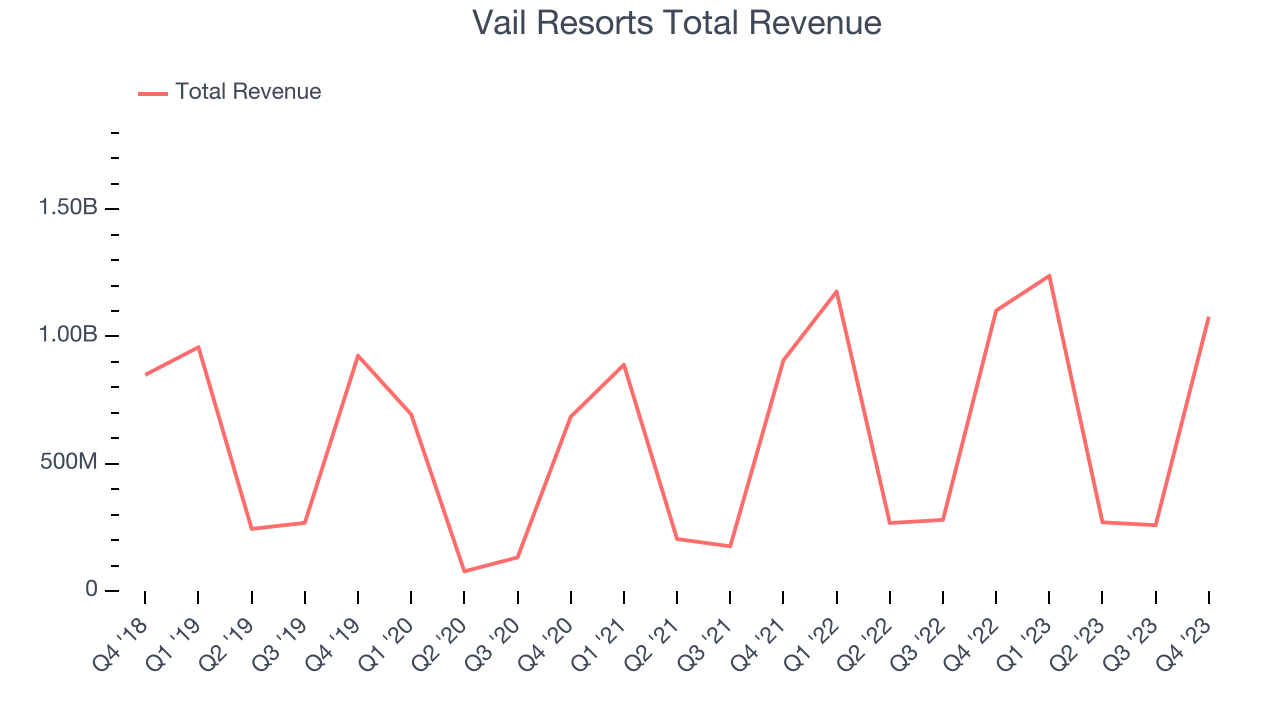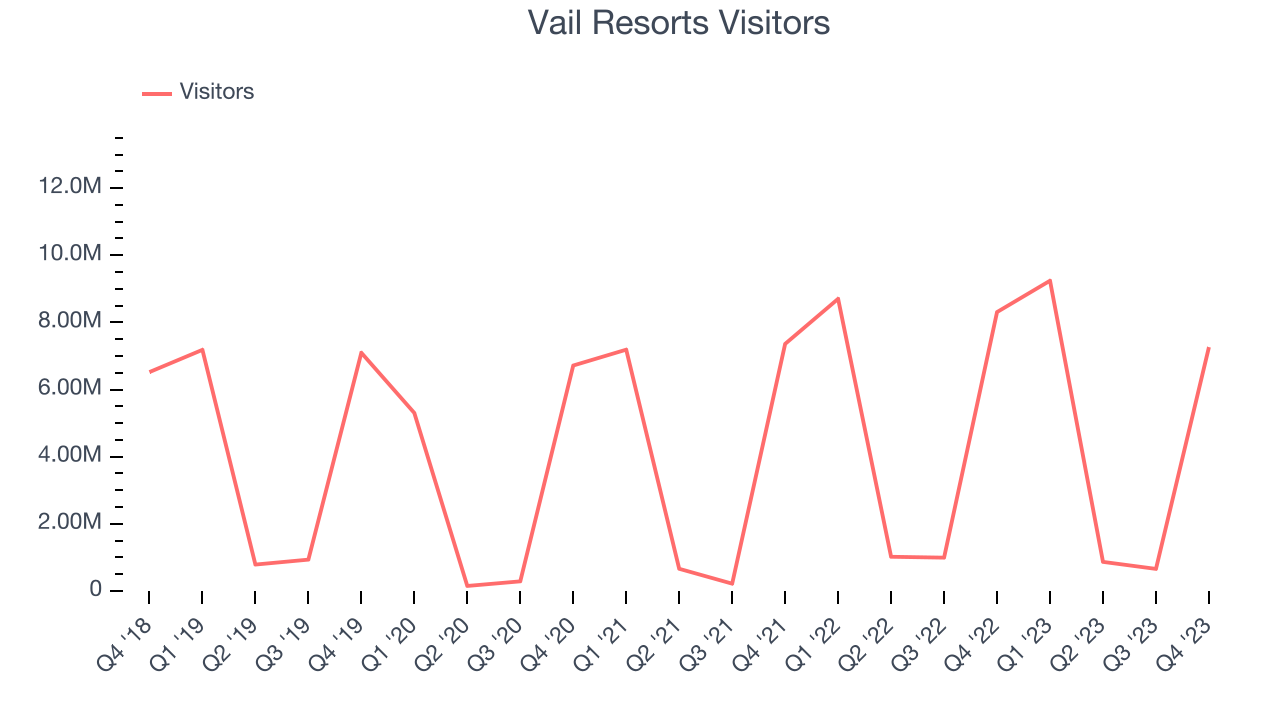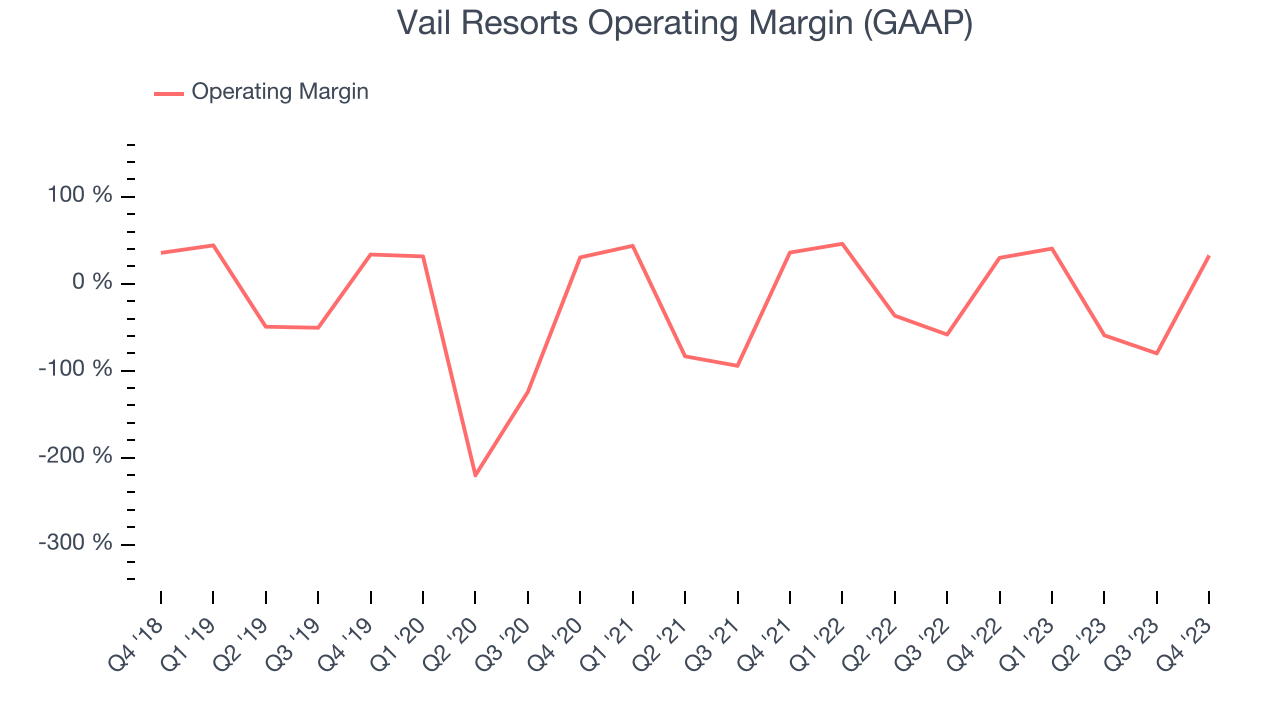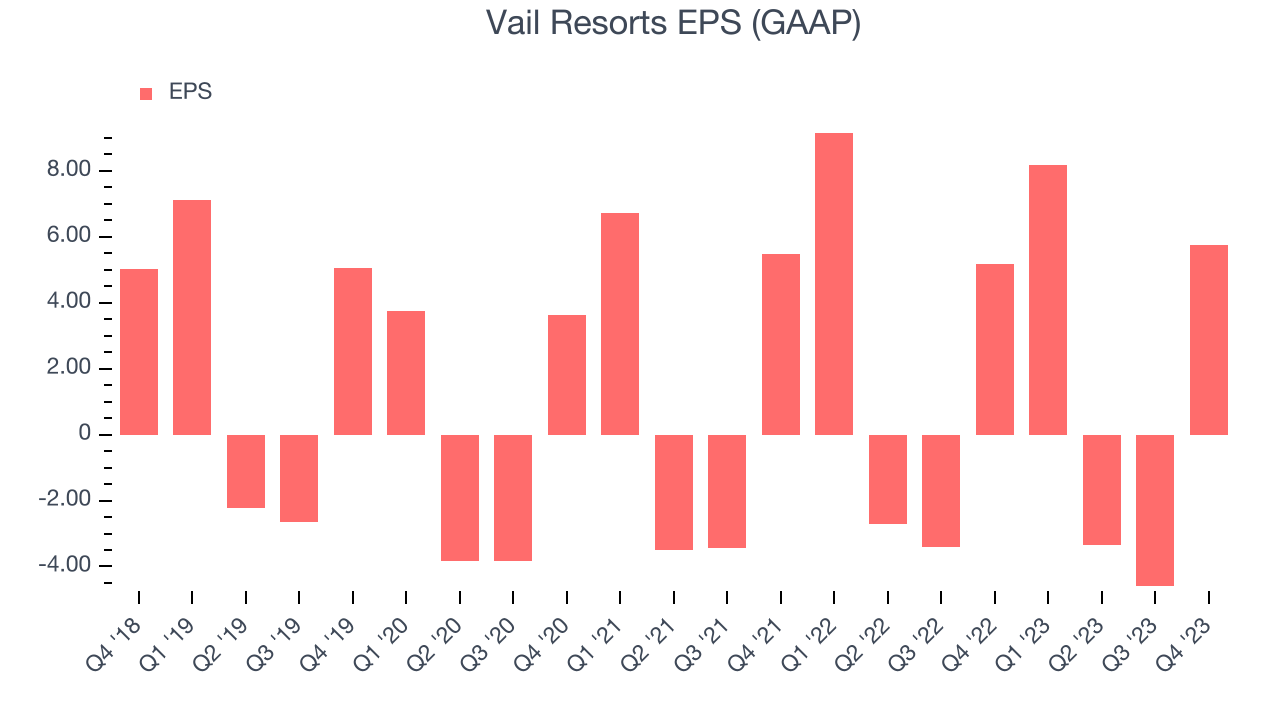Luxury ski resort company Vail Resorts (NYSE:MTN) missed analysts' expectations in Q2 FY2024, with revenue down 2.2% year on year to $1.08 billion. It made a GAAP profit of $5.76 per share, improving from its profit of $5.16 per share in the same quarter last year.
Vail Resorts (MTN) Q2 FY2024 Highlights:
- Revenue: $1.08 billion vs analyst estimates of $1.15 billion (6.5% miss)
- EPS: $5.76 vs analyst expectations of $5.99 (3.8% miss)
- Gross Margin (GAAP): 50%, up from 46.5% in the same quarter last year
- Visitors: 7.26 million
- Market Capitalization: $8.50 billion
Founded by two Aspen, Colorado ski patrol guides, Vail Resorts (NYSE:MTN) is a mountain resort company offering luxury experiences in over 30 locations across the globe.
Vail Resorts emerged from the vision of Pete Seibert and Earl Eaton. Inspired by the breathtaking beauty of the Colorado Rockies, they envisioned a world-class skiing destination that would cater to those seeking both adventure and luxury. The duo's dream, however, was not merely to introduce another ski destination, but to elevate the entire skiing experience.
While many resorts pride themselves on either their slopes or amenities, Vail Resorts has meticulously created a blend of both. The company uses advanced snowmaking systems to ensure optimal ski conditions and complements its slopes with fine dining experiences epitomizing alpine luxury. Beyond skiing, Vail introduces guests to a variety of cultural and recreational experiences to provide guests with memorable experiences regardless of the season.
Vail Resorts's business model leverages a combination of mountain operations, lodging, and real estate. Its diversified revenue streams include lift ticket sales, ski school services, dining, retail, and lodging sales.
Leisure Facilities
Leisure facilities companies often sell experiences rather than tangible products, and in the last decade-plus, consumers have slowly shifted their spending from "things" to "experiences". Leisure facilities seek to benefit but must innovate to do so because of the industry's high competition and capital intensity.
Competitors offering luxury ski resort experiences include Alterra Mountain Company and Boyne Resorts while companies offering cheaper leisure experiences include SeaWorld (NYSE:SEAS) and Six Flags (NYSE:SIX).Sales Growth
A company’s long-term performance can give signals about its business quality. Even a bad business can shine for one or two quarters, but a top-tier one may grow for years. Vail Resorts's annualized revenue growth rate of 6% over the last five years was weak for a consumer discretionary business.

Within consumer discretionary, a long-term historical view may miss a company riding a successful new product or emerging trend. That's why we also follow short-term performance. Vail Resorts's annualized revenue growth of 14.4% over the last two years is above its five-year trend, suggesting some bright spots.
We can dig even further into the company's revenue dynamics by analyzing its number of visitors, which reached 7.26 million in the latest quarter. Over the last two years, Vail Resorts's visitors only grew slightly, showing the company has been generating revenue growth through higher prices for both lift tickets and on-mountain dining.

This quarter, Vail Resorts missed Wall Street's estimates and reported a rather uninspiring 2.2% year-on-year revenue decline, generating $1.08 billion of revenue. Looking ahead, Wall Street expects sales to grow 10.8% over the next 12 months, an acceleration from this quarter.
Operating Margin
Operating margin is a key measure of profitability. Think of it as net income–the bottom line–excluding the impact of taxes and interest on debt, which are less connected to business fundamentals.
Vail Resorts has been a well-managed company over the last eight quarters. It's demonstrated it can be one of the more profitable businesses in the consumer discretionary sector, boasting an average operating margin of 19.2%.
This quarter, Vail Resorts generated an operating profit margin of 32.5%, up 2.7 percentage points year on year.
Over the next 12 months, Wall Street expects Vail Resorts to become more profitable. Analysts are expecting the company’s LTM operating margin of 17% to rise to 22.3%.EPS
Analyzing long-term revenue trends tells us about a company's historical growth, but the long-term change in its earnings per share (EPS) points to the profitability and efficiency of that growth–for example, a company could inflate its sales through excessive spending on advertising and promotions. 
Over the last five years, Vail Resorts's EPS dropped 86.7%, translating into 13.3% annualized declines. Luckily, Vail Resorts has bucked its trend as of late, growing its EPS over the last three years. We'll see if the company can maintain its growth.
In Q2, Vail Resorts reported EPS at $5.76, up from $5.16 in the same quarter a year ago. This print unfortunately missed analysts' estimates. Over the next 12 months, Wall Street expects Vail Resorts to grow its earnings. Analysts are projecting its LTM EPS of $5.98 to climb by 66.8% to $9.98.
Return on Invested Capital (ROIC)
EPS and free cash flow tell us whether a company was profitable while growing revenue. But was it capital-efficient? A company’s ROIC explains this by showing how much operating profit a company makes compared to how much money the business raised (debt and equity).
Although Vail Resorts has shown solid business quality lately, it historically did a subpar job investing in profitable business initiatives. Its five-year average return on invested capital was 14.2%, somewhat low compared to the best consumer discretionary companies that pump out 25%+.
The trend in its ROIC, however, is often what surprises the market and drives the stock price. Over the last two years, Vail Resorts's ROIC averaged 9.7 percentage point increases each year. The company's rising ROIC is a good sign and could suggest its competitive advantage or profitable business opportunities are expanding.
Key Takeaways from Vail Resorts's Q2 Results
We struggled to find many strong positives in these results. Its revenue and EPS unfortunately missed Wall Street's estimates as its number of visitors fell 9.7% year-on-year. That decrease was driven by unfavorable weather conditions as the company's western North American ski resorts saw ~42% lower snowfall. Whistler Blackcomb and the company's Lake Tahoe properties were particularly impacted. Total lift revenue, however, saw a 2.6% increase as it charged higher prices to its customers.
Looking ahead, Vail Resorts lowered its full-year revenue and EPS guidance based on the soft start to the ski season. Overall, the results could have been better, but we note much of the company's underperformance was due to seasonal factors. The stock is down 7.4% on the results and currently trades at $208 per share.
Is Now The Time?
Vail Resorts may have had a tough quarter, but investors should also consider its valuation and business qualities when assessing the investment opportunity.
We think Vail Resorts is a good business. Although its revenue growth has been uninspiring over the last five years, its growth over the next 12 months is expected to be higher. And while its declining EPS over the last five years makes it hard to trust, its projected EPS for the next year implies the company's fundamentals will improve. On top of that, its number of visitors have surged over the last two years.
Vail Resorts's price-to-earnings ratio based on the next 12 months is 22.4x. There are definitely a lot of things to like about Vail Resorts, and looking at the consumer discretionary landscape right now, it seems to be trading at a pretty interesting price.
Wall Street analysts covering the company had a one-year price target of $255.10 per share right before these results (compared to the current share price of $210), implying they saw upside in buying Vail Resorts in the short term.
To get the best start with StockStory, check out our most recent stock picks, and then sign up for our earnings alerts by adding companies to your watchlist here. We typically have the quarterly earnings results analyzed within seconds of the data being released, and especially for companies reporting pre-market, this often gives investors the chance to react to the results before the market has fully absorbed the information.
